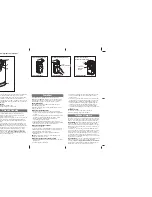
4
WHAT TO EXPECT FROM A CLASS 1, 2, 3 OR 4 OPERATOR
SAFETY INSTRUCTIONS REGARDING PRIMARY & SECONDARY
ENTRAPMENT PROTECTION.
This unit is provided with two means of entrapment protection
(see UL-325). A gate operator shall provide one
Primary
(inherent) and one
Secondary
entrapment feature.
Primary:
(Type A) Inherent entrapment sensing systems
The MEGA SLIDE UL will reverse direction when the inherent type
“A” device senses an obstruction.
Secondary:
(Type B1 & B2) Provision for connection of a contact
and non-contact sensor (photo electrics, see UL-325 approved).
The MEGA SLIDE UL will stop and sound the alarm when a B1
type device is activated.
Primary protection
designated type A inherent protection. Unit
will reverse direction when an obstruction is sensed while moving
in either direction. Sensitivity is adjusted by IRD1 on the control
board. While closing, if an obstruction is sensed by the primary
inherent sensor, the gate will reverse and open to the full open
position. The gate will remain there until a close command is
received or will close by timer after new input is received. In
order for the gate to close by timer (if activated) a new input on
terminals J5 1-8 must be given. If an input is still present when
the gate reached the full open position, this input will need to be
renewed or removed and another input given before the close
timer will close the gate.
Entrapment alarm
will activate upon the primary inherent sensor
sensing a second obstruction before reaching a limit switch. Once
activated, gate will remain at rest and the alarm will sound. This
condition can only be cleared by an input applied to J5 #4. The
wiring used to reset the operator must be in the line of sight and
must be an “intended” reset. Access control devices of any kind
that required intended (on purpose) activation may be used for
this reset. Devices that will cause an incidental reset (vehicle
detectors, probes, timers, motion sensors, photo beams, etc.)
must not be used. Failure to comply with this requirement may
result in serious injury or death.
UL-325 DEFINITION OF GATE OPERATOR CLASSES
Residential Vehicular Gate Operator - Class I:
A vehicular gate operator/system intended for use in a home of
one-to four single family dwelling, or garage or parking area
associated therewith.
Commercial/General Access Vehicular Gate Operator - Class II:
A vehicular gate operator/system intended for use in a
commercial location or building such as a multi-family housing
unit (five or more single family units), hotels, garages, retail
stores, or other buildings servicing the “general public.”
Industrial/Limited Access Vehicular Gate Operator - Class III:
A vehicular gate operator/system intended for use in industrial
locations or buildings such as factories, loading dock areas or
other locations not intended to service the general public.
Restricted Access Vehicular Gate Operator - Class IV:
A vehicular gate operator/system intended for use in guarded
industrial locations or buildings, such as airport security areas or
other restricted access locations “not” serving the general public,
in which unauthorized access is prevented via supervision by
security personnel.
UL-325 APPROVED PHOTO BEAMS & CONTACT EDGES
Photo beams (non-contact sensor) required:
• OMRON/MMTC Model E3K-R10K4-NR
Retro-reflective type
• Allen-Bradley Model 60-2728 (with 2m cable)
Retro-reflective type
• Allen-Bradley Model 60-2729 (with 5 pin term)
Retro-reflective type
Safety edges (contact edge):
• Miller edge models
ME-120, ME-123, MG-020, MG020, MGR20, MGS20
Normally open contact
Содержание LIFTMASTER PROFESSIONAL MSLDCBB
Страница 18: ...18 OPERATOR NOTES...





































